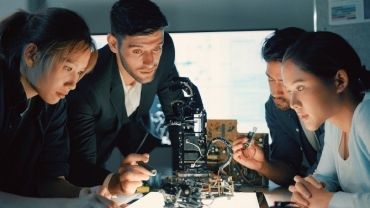

“It’s a very different world”: Katy Dowding, Skanska
How technology is creating a safer, smarter and more agile construction industry that can respond to changing demands on places and spaces.
Agility may not be the first word that springs to mind when thinking about the concrete, steel and heavy machinery of the construction industry, but Katy Dowding, CEO of Skanska UK, is committed to driving transformation across her organisation and sector to create more agile spaces, in more agile ways.
“The need for agility in business models is going to continue,” she says.
“The organisations that will survive are not necessarily the ones who can predict the future but the ones who are able to respond to new futures as they emerge.”
The “new future” for Skanska is shaped by the power of technology but also the lingering effects of a pandemic that has left organisations trying to establish what spaces they need while people work out what changed working patterns mean for where they want to live.
“What we're seeing more and more with the spaces we're designing and developing is the need to create agility,” she says.
“Since COVID, many organisations need less floor space because fewer people are coming into the office, or using their space differently. That’s creating a movement from areas like Canary Wharf back into the city because they can now afford to be there. But then that space in Canary Wharf is repurposed to other sectors such as life sciences and datacentres.”
“So you’re seeing this constant shift within the market and for us that's about being able to create agility with our smart buildings that can adapt. So they might be an office block today, but they might be life sciences tomorrow.”
Dowding says the majority of Skanska's building projects are significant refurbishments of existing buildings, to create more adaptable spaces, repurpose them or meet growing demand for more carbon efficient spaces.
Datacentres are an area of particular demand as more organisations move their IT systems infrastructure from on-premise to the cloud.
That trend towards cloud technologies, and improved connectivity, is also enabling the quicker adaptation of premises.
Embracing technological change
“Once upon a time, when you had banks and banks of filing cabinets with all your paperwork, things were a lot harder to move,” says Dowding. “Now you’ve just got a docking station. So we're seeing a lot more agility in the buildings that we're able to provide.”
Technology is also transforming how Skanska works on projects such as HS2, the high-speed railway - with safety improvements a primary concern in the construction industry.
“The number one priority is safety and eliminating accidents,” says Dowding.
“Technology is helping us move away from an approach of managing risks to actually eliminating the risks.”
“One of the highest risks is people being injured by moving vehicles. We’re now moving people out of the area with driverless vehicles, and we’re using human form recognition so when the machine senses a person it will automatically stop.”
“And on HS2, where we’re tunnelling, we have the ring segments coming in by train and getting taken all the way down the tunnel by robotics. So again removing people from areas of risk.”
And technology transformation is delivering significant benefits in terms of productivity and efficiency.
A data-driven organisation
“We're seeing much bigger use of data in terms of production control on our projects,” says Dowding. “We have sensors on everything on our projects, monitoring and tracking, and we can analyse that data. We also have systems where people walk around with a camera fixed to their helmet, so they can just walk around and it records our progress.”
“We can track actual progress compared to planned progress, then identify if we’re ahead anywhere or behind anywhere and that gives us options for reprogramming and sequencing. So if we drop behind, we can work out where we can make up the time, or if we’re ahead how we further capitalise on gain.”
Dowding compares that instant assessment of progress, through data and visuals, and the real-time view afforded of the supply chain and resource, and compares it to a past where site visits were part of an often days-long and heavily manual process of obtaining a fraction of the same insight.
Creating a data-driven single view of the organisation has enabled Skanska to bring greater efficiency to planning and project management.
A different world
Dowding gives the example of being able to identify and address supply chain issues before they become an issue on a site, redirecting materials, such as plasterboard, to a project to optimise timelines and avoid the inefficiency of one site having plasterboard they’re not ready to use, while another site is delayed because it’s ready but lacks the materials.
“We have architects, engineers, site teams, suppliers all working on the same system with the same information.”
In line with that Dowding is committed to training and upskilling to enable teams to take full advantage of technology. She warns organisations against the “false economy” of cutting training budgets in a challenging economy, because they will lose ground at a time when technology is driving high-paced change. One of the newest tech tools Skanska staff have access to is an internal generative AI tool to help them work more efficiently on tasks such as reviewing or drafting documentation.
Dowding says such a focus on technology and data makes construction feel like a transformed industry.
“It's a very different world to the one I joined 34 years ago.”
Contact us










